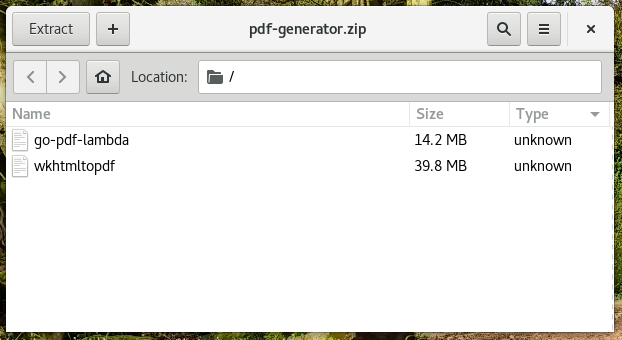AWS Lambda PDF Generator · GolangCode
阿新 • • 發佈:2018-12-29
This is an example of how to convert HTML code into a PDF using AWS’ Lambda service and S3 Triggers. So that once a HTML file is upload to S3 it will automatically be converted into a PDF which should appear in the same bucket shortly after - all using a serverless function.
To do this, other than the standard library, we’re using a Go wkhtmltopdf library and the Go AWS sdk. The wkhtmltopdf Go libaray is a wrapper to the binary file - which will need to be included in our final zip file that we upload to lambda.
package main import ( "bytes" "context" "fmt" "io" "log" "os" "strings" "github.com/SebastiaanKlippert/go-wkhtmltopdf" "github.com/aws/aws-lambda-go/events" "github.com/aws/aws-lambda-go/lambda" "github.com/aws/aws-sdk-go/aws" "github.com/aws/aws-sdk-go/aws/session" "github.com/aws/aws-sdk-go/service/s3" ) var sess *session.Session func init() { // Let wkhtmltopdf where to find our bin file (in the zip) os.Setenv("WKHTMLTOPDF_PATH", os.Getenv("LAMBDA_TASK_ROOT")) // Setup AWS S3 Session (build once use every function) sess = session.Must(session.NewSession(&aws.Config{ Region: aws.String("eu-west-1"), })) } func main() { // Start() is when Lambda will connect and start running functions. // Everything before this is setup, and anything after won't be run. lambda.Start(LambdaHandler) } func LambdaHandler(ctx context.Context, s3Event events.S3Event) { for _, record := range s3Event.Records { fmt.Printf( "[%s - %s] Bucket = %s, Key = %s \n", record.EventSource, record.EventTime, record.S3.Bucket.Name, record.S3.Object.Key, ) err := ProcessFile(record) if err != nil { log.Println(err) continue } } } // ProcessFile handles a single S3 event, this will do the conversion from HTML // to PDF for a single file only and write it back to it's origin. func ProcessFile(record events.S3EventRecord) error { s3Item := record.S3 // Get the HTML file from S3 obj, err := s3.New(sess).GetObject(&s3.GetObjectInput{ Bucket: &s3Item.Bucket.Name, Key: &s3Item.Object.Key, }) defer obj.Body.Close() pdfBytes, err := GeneratePDF(obj.Body) if err != nil { return err } // Replace .html filename with .pdf newKey := strings.Replace(s3Item.Object.Key, ".html", ".pdf", -1) fmt.Println("Rename to: " + newKey) // Put the PDF back onto S3 fmt.Println("Save File to: " + s3Item.Bucket.Name) _, err = s3.New(sess).PutObject(&s3.PutObjectInput{ Bucket: &s3Item.Bucket.Name, Key: &newKey, Body: bytes.NewReader(pdfBytes), }) return err } // GeneratePDF converts the file body from S3 into a PDF as a byte array to // write back to S3. func GeneratePDF(s3Obj io.Reader) ([]byte, error) { pdfg, err := wkhtmltopdf.NewPDFGenerator() if err != nil { return nil, err } // Pass S3 Object body (as reader) directly into wkhtmltopdf pdfg.AddPage(wkhtmltopdf.NewPageReader(s3Obj)) // Create PDF document in internal buffer if err := pdfg.Create(); err != nil { return nil, err } // Return PDF as bytes array return pdfg.Bytes(), nil }
For this to work, you’ll need to:
- Name the code above
go-pdf-lambda.goand rungo build go-pdf-lambda.goto make the binary file. - Set your Lambda root Handler to the go binary filename (
go-pdf-lambdain our example) - Give your lambda function/role read & write permissions to S3 (through IAM)
- Include a copy of wkhtmltopdf along with your lambda file inside the zip (download here)
How the zip file should look:

